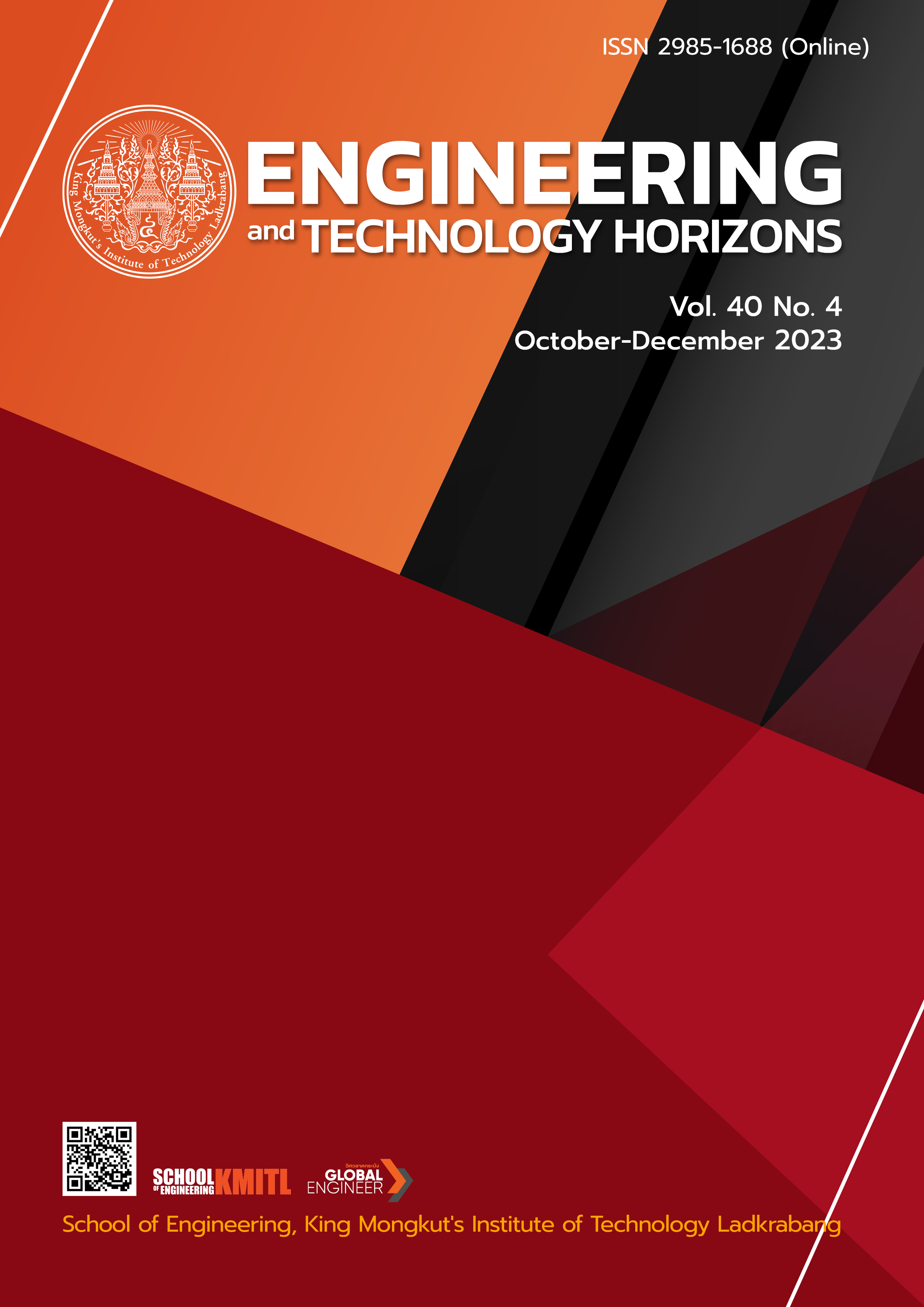พฤติกรรมการวิบัติของผนังอิฐภายใต้แรงกระทำแบบสองทิศทาง
DOI:
https://doi.org/10.55003/ETH.400410คำสำคัญ:
ผนังก่ออิฐ, แรงกระทำแบบสองทิศทาง, การวิบัติจากแรงเฉือนทแยง, กำลังดึงบทคัดย่อ
งานวิจัยนี้มีวัตถุประสงค์เพื่อศึกษาพฤติกรรมการวิบัติของผนังก่ออิฐภายใต้แรงกระทำแบบสองทิศทาง (แนวดิ่งและแรงกระทำด้านข้าง) สำหรับประยุกต์ใช้งานก่อสร้างอาคารชุมชนขนาดเล็กที่รับน้ำหนักไม่มาก โดยทดสอบอิฐ 3 ประเภท ได้แก่ อิฐมอญ อิฐมวลเบา และอิฐบล็อก ตามมาตรฐานผลิตภัณฑ์อุตสาหกรรมของอิฐแต่ละประเภท สำหรับการทดสอบความสามารถในการรับแรงของผนังก่ออิฐ ใช้ผนังก่อแบบเต็มแผ่นและแบบครึ่งแผ่น ขนาดกว้าง 1.0 เมตร × 1.0 เมตร 3 รูปแบบแตกต่างกัน ได้แก่ 1) แบบไม่มีช่องว่าง 2) แบบมีช่องหน้าต่าง และ 3) แบบมีช่องประตู รับแรงกระทำแนวดิ่งและด้านข้าง ผลการศึกษาพบว่า รูปแบบหลักในการวิบัติเป็นการวิบัติจากแรงเฉือนทแยง และเกิดจากแรงกระทำด้านข้างมากกว่าแรงแนวดิ่ง โดยผนังก่ออิฐที่รับแรงแนวดิ่งไม่มีรอยแตกร้าวเกิดขึ้นเนื่องจากเป็นการทดสอบแบบไม่ทำลาย ส่วนผนังก่ออิฐที่รับแรงกระทำด้านข้างเกิดรอยแตกร้าวอยู่ในแนวทแยงรูปแบบขั้นบันไดและเป็นเส้นตรงเป็นรูปแบบหลัก ผนังก่ออิฐมอญทั้งแบบครึ่งแผ่นและแบบเต็มแผ่นมีรอยแตกร้าวชัดกว่าผนังก่ออิฐบล็อกและผลังก่ออิฐมวลเบา มีทั้งการแตกร้าวระหว่างผิวสัมผัสของอิฐกับปูนก่อ การแตกร้าวผ่านก้อนอิฐ และการแตกร้าวที่อิฐและปูนก่อแตกไปด้วยกัน ผนังก่ออิฐแบบมีช่องหน้าต่างและช่องประตูซึ่งมีพื้นที่ก่ออิฐคิดเป็นร้อยละ 82 และ 76 ของผนังก่ออิฐแบบไม่มีช่องว่าง สามารถรับแรงกระทำจนวิบัติได้น้อยกว่าโดยเฉลี่ยประมาณร้อยละ 48 และ 70 และยังพบว่ากำลังของผนังก่ออิฐขึ้นอยู่กับกำลังดึงของอิฐก่อและกำลังรับแรงเฉือนของปูนก่ออีกด้วย
References
N. N. Thaickavil and J. Thomas, “Behavior and strength assessment of masonry prism,” Case Studies in Construction Materials, vol. 8, pp. 23–38, 2018, doi: 10.1016/j.cscm.2017.12.007.
H. B. Kaushik, D. C. Rai and S. K. Jain, “Stress-strain characteristics of clay brick masonry under uniaxial compression,” Journal of Materials in Civil Engineering, vol. 19, no. 9, pp. 728–739, 2007, doi: 10.1061/(ASCE)0899-1561(2007)19:9(728).
G. Sarangapani, B. V. Venkatarama Reddy and K. S. Jagadish, “Brick-motar bond and masonry compressive strength,” Journal of Materials in Civil Engineering, vol. 17, no. 2, pp. 229–237, 2005, doi: 10.1061/(ASCE)0899-1561(2005)17:2(229).
A. Brencich and L. Gambarotta, “Mechanical response of solid clay brickwork under eccentric loading. Part I: Unreinforced masonry,” Materials and Structures, vol. 38, no. 2, pp. 257–266, 2005, doi: 10.1007/BF02479351.
L. Berto, A. Saetta, R. Scotta and R. Vitaliani, “Failure mechanism of masonry prism loaded in axial compression: computation aspects,” Materials and Structures, vol. 3, no. 2, pp. 249–256, 2005, doi: 10.1007/BF02479350.
S.B. Singh and P. Munjal, “Bond strength and compressive stress-strain characteristics of brick masonry,” Journal of Building Engineering, vol. 9, pp. 10–16, 2017, doi: 10.1016/j.jobe.2016.11.006.
M. B. Ravula and K. V. L. Subramaniam, “Experimental investigation of compressive failure in masonry brick assemblages made with soft brick,” Materials and Structures, vol. 50, no. 19, pp. 1–11, 2017, doi: 10.1617/s11527-016-0926-1.
M. C. Griffith, N. T. Lam, J. L. Wilson and K. Doherty, “Experimental investigation of unreinforced brick masonry walls in flexure,” Journal of Structural Engineering, vol. 130, no. 3, pp. 423–432, 2004, doi: 10.1061/(ASCE)0733-9445(2004)130:3(423).
P. Alcaino and H. Santa-Maria, “Experimental response of externally retrofitted masonry walls subjected to shear loading,” Journal of Composites for Construction, vol. 12, no. 5, pp. 489–498, 2008, doi: rg/10.1061/(ASCE)1090-0268(2008)12:5(489).
I. S. Kolsida, A. K. Tomor and C. A. Booth, “Experimental evaluation of changes in strain under compressive fatigue loading of brick masonry,” Construction and Building Materials, vol. 162, pp. 104–112, 2018, doi: 10.1016/j.conbuildmat.2017.12.016.
P. Joyklad and Q. Hussain, “Experimental study on axial and diagonal compressive behavior of brick masonry walls,” Kasem Bundit Engineering Journal, vol. 8, no. 2, pp. 1–20, 2018.
R. Werasak, J. Meng and K. Ratchaneewan, “Behaviors of historic masonry walls retrofitted with GFRP under axial load,” Advanced Materials Research, vols. 133–134, pp. 959–964, 2010, doi: 10.4028/www.scientific.net/AMR.133-134.959.
R. Kerdmongkon, M. Jing and W. Raongjant, “Study on the behavior of ancient masonry walls retrofitted using glass fiber reinforced polymer under axial load,” in Proc. 15th Nation Convention on Civil Engineering (NCCE15), UbonRatchathani, Thailand, May. 12–14, 2010, pp. MAT06-1–MAT06-6.
P. Odthon and N. Yoosuk, “Behavior of lightweight concrete block wall subjected to axial load,” B.E. thesis, Dept. Civil Eng., Burapha Univ., Chonburi, Thailand, 2007.
K. Kaewthep and P. Phaichaleam, “The behavior of lightweight reinforced mortar wall under compression load,” B.E. thesis, Dept. Civil Eng., Burapha Univ., Chonburi, Thailand, 2017.
S. Leelataviwat and P. Warnitchai, “Lessons from damage to small and medium-sized buildings in the event of the Mae Lao earthquake Chiang Rai Province,” in Lessons from the Mae Lao Earthquake, Chiang Rai, Disaster Nearby Seminar, Bangkok, Thailand, Nov. 20, 2014, pp.99–114.
K. M. Dolatshahi, A. J. Aref and M. Yekrangnia, “Bidirectional behavior of unreinforced masonry walls,” Earthquake Engineering & Structural Dynamics, vol. 43, no. 15, pp. 2377–2397, 2014. doi: 10.1002/eqe.2455
K. M. Dolatshahi, A. J. Aref and M. Yekrangnia, “A Study of Multi-Directional Response of Unreinforced Masonry Walls,” in Second European Conference on Earthquake Engineering and Seismology, Istanbul, Turkey, Aug. 25–29, 2014, pp.1–10.
K. M. Dolatshahi and A. J. Aref, “Multi-directional response of unreinforced masonry walls: experimental and computational investigations,” Earthquake Engineering & Structural Dynamics, vol. 45, no. 9, pp.1427–1447, 2016, doi: 10.1002/eqe.2714.
T. Deb, T. Y. P. Yuen, D. Lee, R. Halder and Y. C. You, “Bi-directional collapse fragility assessment by DFEM of unreinforced masonry building with opening and different configurations,” Earthquake Engineering & Structural Dynamics, vol. 50, no. 15, pp. 4097–4120, 2021, doi: 10.1002/eqe.3547.
Thai Industrial Standard for Half Red Brick, Tis no. 77-2545, Thai Industrial Standard Institute (TISI), Ministry of Industry, Bangkok, Thailand, 2002.
Thai Industrial Standard for Concrete Block, Tis no. 57-2560, Thai Industrial Standard Institute (TISI), Ministry of Industry, Bangkok, Thailand, 2017.
Thai Industrial Standard for Lightweight Brick, Tis no. 1505–2541, Thai Industrial Standard Institute (TISI), Ministry of Industry, Bangkok, Thailand, 2013.
Standard Test Method for Diagonal Tension (shear) in Masonry Assemblages, ASTM E519-02, American Society for Testing and Materials, West Conshohocken, PA, USA, 2002.
G. Lan, Y. Wang, L. Xin and Y. Liu, “Shear test method analysis of earth block masonry mortar joints,” Construction and Building Materials, vol. 264, 2020, Art. no. 119997, doi: 10.1016/j.conbuildmat.2020.119997.
Standard Test Method of Sampling and Testing Brick and Structural Clay, ASTM C67-97, American Society for Testing and Materials, West Conshohocken, PA, USA, 1997.
Standard Specification for Building Brick, ASTM C62-69, American Society for Testing and Materials, West Conshohocken, PA, USA, 2001.
E. Minaie, F. L. Moon and A. A. Hamid, “Nonlinear finite element modeling of reinforced masonry shear walls for bidirectional loading response,” Finite Elements in Analysis and Design, vol. 84, pp. 44–53, 2014, doi: 10.1016/j.finel.2014.02.001.
A. Chomvong, “Strength of Brickwall Subjected to Lateral Load,” M.E. thesis, Dept. Civil Eng., Chulalongkorn Univ., Bangkok, Thailand, 1982.
Downloads
เผยแพร่แล้ว
How to Cite
ฉบับ
บท
License
Copyright (c) 2023 คณะวิศวกรรมศาสตร์ สถาบันเทคโนโลยีพระจอมเกล้าเจ้าคุณทหาร

This work is licensed under a Creative Commons Attribution-NonCommercial-NoDerivatives 4.0 International License.
บทความที่ได้รับการตีพิมพ์เป็นลิขสิทธิ์ของคณะวิศวกรรมศาสตร์ สถาบันเทคโนโลยีพระจอมเกล้าเจ้าคุณทหารลาดกระบัง
ข้อความที่ปรากฏในบทความแต่ละเรื่องในวารสารวิชาการเล่มนี้เป็นความคิดเห็นส่วนตัวของผู้เขียนแต่ละท่านไม่เกี่ยวข้องกับสถาบันเทคโนโลยีพระจอมเกล้าเจ้าคุณทหารลาดกระบัง และคณาจารย์ท่านอื่นๆในสถาบันฯ แต่อย่างใด ความรับผิดชอบองค์ประกอบทั้งหมดของบทความแต่ละเรื่องเป็นของผู้เขียนแต่ละท่าน หากมีความผิดพลาดใดๆ ผู้เขียนแต่ละท่านจะรับผิดชอบบทความของตนเองแต่ผู้เดียว






